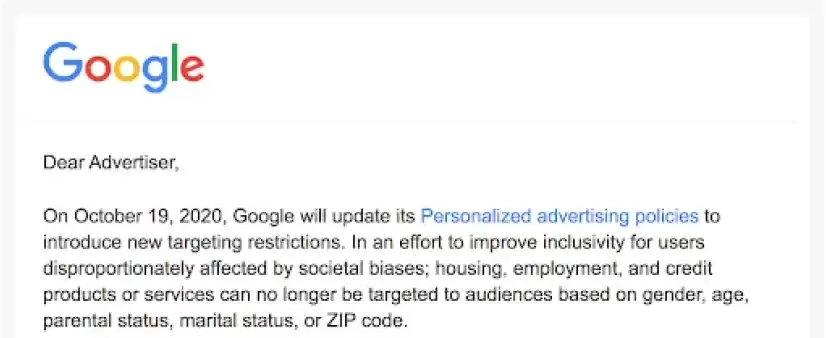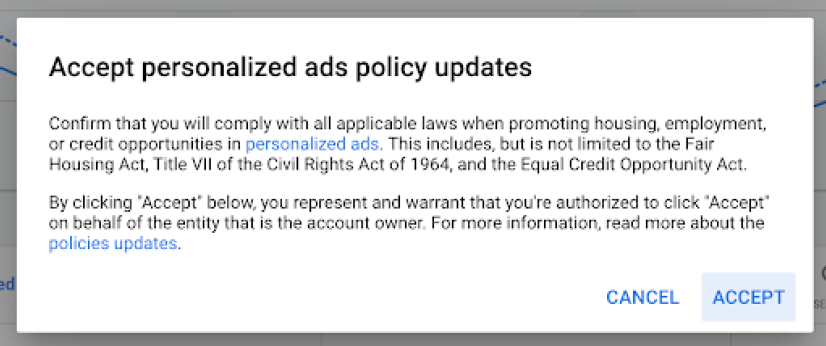Imagine, you pull up your email and find an inbox chock-full of new Google ad disapprovals. Worse, you see that these disapprovals caused your ads to stop running. If you’ve been in digital marketing for a while, receiving ad disapprovals is nothing new to you. You might even be at the point where you cackle at some of the erroneous reasoning behind some of the disapprovals. What might be new, however, is why those ads were flagged.
What Google policy updates specifically changed?
In early June 2020, Google announced upcoming changes to their personalized advertising policies for housing, employment, and credit in the U.S. and Canada that would take effect on October 19. The search behemoth is known to change things seemingly out of nowhere, but this announcement was not a matter of if, but when, driven by increased public and legislative scrutiny over the handling of sensitive user data. Other tech giants like Facebook implemented a similar change last year.
We received an email from Google around the middle of August that delved into more specifics, an excerpt of which can be found below:

In short, Google is following the likes of Facebook in updating their personalized advertising policies by restricting targetable audiences for advertisers within the housing, employment, and credit products and services industries in the U.S. and Canada. These restricted audiences include: gender, age, parental status, marital status, or ZIP code. Click here to find more examples of what is considered in scope for restriction under Google’s new updates.
Why did they make these updates?
The “TL;DR” of it is to comply with regulations. Per Google, “In an effort to improve inclusivity for users disproportionately affected by societal biases...”.
Companies like Google face increasing pressure from stakeholders to be responsible data stewards as a result of recent high-profile data incidents like the Cambridge Analytica fiasco. They also don’t need any more reasons to be in hotter water with lawmakers.
Consequently, Google mentions that they’ve been working with the U.S. Department of Housing and Urban Development (HUD), civil rights and housing experts, and the advertising industry at large to shape new advertising policies. It’s incumbent upon advertisers to adhere to these policies, and fortunately, Google will flag any facet of your account that is in violation of them (sometimes incorrectly).
How will these changes affect digital marketers?
Impacted advertisers will have 60 days to accept the policy within Google Ads, as shown below:

Not accepting the policy update will cause affected ads to stop serving, even if your business is not physically located in the U.S. or Canada, and you will not be able to create new campaigns until you’ve accepted the policy. As such, there’s essentially no way of getting around these policy updates if you fall in scope and want to continue running ads.
After accepting the policy update, you’ll still need to change your targeting, even after 60 days have passed. Gone are gender, age, marital and parental status, and ZIP code targeting. Were you adjusting bids based on age? That has to be reverted to 0%. Were you running gender-focused campaigns? Now you have to enable all (you can still target only “Unknown” by setting male and female as exclusions!). Were you running ads for a homebuilder with laser-focused ZIP code targeting? Say hello to radius targeting! However, you can still see reporting for these audiences, but you won’t be able to use them for targeting.
That’s a bummer, what can I do to get around these new restrictions?
Finding the closest proxies to the restricted audiences can be a tricky ordeal. Below are some targeting-related updates we made for one of our own impacted clients, a local homebuilder.
Optimize for user intent
Let’s say that you also run paid search advertising campaigns for a homebuilder, and you were relying on age exclusions to filter for a particular audience. With the updates to Google’s personalized advertising policies, you’re now forced to plug the age targeting-sized hole with another option. One way to do so is by optimizing for user intent. Leveraging intent-based keywords can help make up some of the loss in relevant searches with the absence of age exclusions.
While not a perfect substitute for age inclusion/exclusion, adding gated keywords tailored to your desired target market, “[55+ communities in XYZ]” as opposed to something more generic like “[homes in XYZ],” is allowed even if you fall within scope of the policy updates. These types of keywords capture more intent and position your ads to appear for more relevant searches, especially if you were solely relying on age exclusions to do all the filtering.
Note: Adding keywords that incorporate age won’t prevent individuals below or above your ideal age from searching for your services.
Take advantage of existing targeting options, like household income
Targeting by household income is permitted if your business falls within scope—we were even advised by our Google rep that it would be the best replacement for age targeting, marital status, and parental status.
Income targeting shouldn’t be new, and the reason to use it is self-explanatory, but the absence of the affected demographic targeting options, again, nudges advertisers to leverage this feature, and other targeting methods, more than ever. However, it is up to you to determine how much trust you place into Google’s ability to discern income levels through their algorithms.
We were able to make up for some of the lost accuracy in the absence of age exclusions by layering on minimum household income levels with age-gated keywords for our aforementioned homebuilder client.
Effects on performance
Early results are encouraging when looking at conversion rates for one of our search campaigns we modified for compliance, roughly three weeks before the policy changes took effect.

The campaign saw gains in conversions and conversion rates even with 24% less spend compared to the previous period. What remains to be seen is whether these new leads are qualified. The assuring part is that performance didn’t drop off a cliff in Wile E. Coyote fashion after we adjusted our targeting.
Hopefully, these personalized advertising policy updates did not severely affect your paid search accounts. The path to compliance is thankfully quite easy, as all it takes are a couple of clicks within Google Ads. However, ensuring that your account’s performance stays consistent in light of the new policy changes can be difficult now that you’re left with less exact targeting capabilities.
Need help navigating Google’s endless policy updates and optimizing accordingly? Contact us today.

